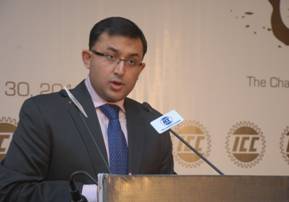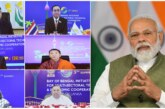
In a step directed to significantly reduce carbon emission from coal mining, the market players should resort to clean coal manufacturing technologies, feels Mr Ganesan Natarajan, WTD, President and CEO – Ennore Coke Ltd. He was speaking at the 3rd India Coal Summit, jointly organized by Indian Chamber of Commerce and Ministry of Coal, Government ofIndia in New Delhi.
While addressing the esteemed gathering, Mr. Natarajan mentioned that coal will continue to occupy centre-stage of India’s energy scenario, with 70% of upcoming power plants projected to be coal-based. It was learnt that the total demand for coal is estimated to touch 731.10 million tonnes by 2011-12, including 725.72 million tonnes of non-coking coal, as per Working Group on Coal for the Eleventh Five Year Plan. On the other hand, coal production in India can reach upto a level of 680 million tonnes which in turn points to the fact that the country would have to depend on imports to meet its shortfall of around 51 million tonnes (MT).
Against the backdrop of growing concerns on environment and impending social hurdles on account of land acquisition for mining, Mr Natarajan stated a that the Ministry needs to develop a proper roadmap by keeping all the stakeholders’ interest in mind. He further elucidated that greater emphasis is required to improve the technological base of the industry to arrest the carbon footprint. Mr. AK Singh, CMD, CMPDIL who was also the Summit Co-Chairman, mentioned that companies should streamline their operations, since 72% of total pollution in the country comes from coal combustion for power generation. Mr Singh opined that companies need to significantly scale up their R&D activities to reduce carbon emission. In addition to this, the Summit witnessed an engaging panel discussion on striking a balance between usage of black fuel in power generation vis-à-vis the government’s thrust on pursuing a greener growth strategy in the coming days.
Along with the above-mentioned speakers, the panelists also included Dr. Hardarshan S Valia, President, Coal Science Inc; Dr. Malti Goel, Former Advisor and Senior Scientist, Ministry of Science and Technology, GoI and Mr. DN Abrol, Executive Director, Jindal Steel and Power. The debate was moderated by Mr. Puneet Goel, Director, KPMG. Dr Valia urged the industry to adopt Japanese Syndrome Policy to reduce the country’s foreign dependence on imported coal by focusing on securing sources of raw materials, achieving self-sufficiency in coke production and ensuring export of excess coke production. Dr Goel gave a detailed presentation on the alternative clean coal technologies that are currently available and mentioned that the industry should look at improving efficiency of coal combustion, promote coal conversion into gas/liquid and actively engage in waste recycling from coal plant.
She further stated that the industry can also look at eliminating carbon emissions by sequestration along with decarbonization of coal. Mr. DN Abrol outlined the importance of private sector participation in meeting the demand requirement of the economy and stressed that a stable and enabling policy framework needs to evolve (in sync with the proposed MMDR Act) to give the much needed boost to the industry. Moreover, all the speakers acknowledged the fact that effective coordination amongst the government ministries and implementation of CSR activities by the mining companies will surely go a long way in promoting inclusive growth and revitalizing the rural economy. The Inaugural Session also witnessed release of a report on ‘The Challenge of Black Fuel and Greener Growth’ jointly prepared by ICC and KPMG. Dr. Rajeev Singh, Director General, ICC delivered the Vote of Thanks of the session which saw overwhelming response from all the stakeholders of the industry.
Speech: Mr. Jayanta Roy, President – ICC:
- Prof S P Gautam, Chairman, Central Pollution Control Board
- Mr Anil Razdan, Former Secretary, Ministry of Power, GoI
- Mr ICP Keshari, Joint Secretary, Ministry of Power
- Mr Prabir Neogi, President, Integrated Coal Mining
- Mr Leonid Geshlin, Deputy Director, Kuzbass Coal
It is indeed my pleasure to welcome you all at the Valedictory Session of the 3rd India Coal Summit, organized jointly by Indian Chamber of Commerce and Ministry of Coal. With Shri Jaiswal at the helm of affairs in the Ministry of Coal, significant reforms have been taking place in various spheres under his jurisdiction. Notable among them is the disinvestment of 10% of the Government’s holding in Coal India Ltd last month which met with resounding success and enabled the PSU to garner much needed financial resources to the tune of US$ 3.46 billion. Another notable achievement of his relates to fast-tracking the setting up of the proposed autonomous coal regulatory body and the modified MMDR Act which is expected to give a major boost to mining activities in the country. Under his leadership, the Ministry is currently undergoing the world’s biggest rehabilitation work, which was being awaited for the last 40 years. In this regard, the Government has allotted Rs 10,000 Crores for the rehabilitation work spread across the eastern states.
Indian Chamber of Commerce has a very strong focus upon the Infrastructure sector and ICC today is the foremost Industry Chamber in the country which organizes annual strategic conferences on key sectors like Energy & Power, Mining, Steel and Coal. The Chamber’s initiatives in the Infrastructure space during the last couple of years have gained tremendous momentum, and prestigious Summits like the India Energy Summit, India Coal Summit, Summit on Mining to Steel Making, Electricity East and Summit on Em-Powering North-East, have emerged as extremely important annual platforms which have addressed key issues in these sectors of significant importance. These Conferences witnessed the participation of key Policy Makers, Regulators and Industry Captains, and paved the way for future policy changes by bringing all relevant stakeholders under one umbrella. I would also like to point out that the Chamber’s first ever summit on Indian Public Sector Agenda@2015 will be held tomorrow in the city.
 India is the world’s third largest coal producer with total coal production growing at a CAGR of 5.5% during the last decade. The year-on-year growth in production has accelerated in the past few years against the backdrop of rapid growth in domestic demand and deployment of advanced mining technologies by the industry. At the state-level, Orissa, Chhattisgarh, Jharkhand, Madhya Pradesh and Andhra Pradesh account for over four-fifths of the country’s total coal production. Coal mining in India is carried out predominantly through open cast mining, unlike China where underground mining is widely used. Underground mining has failed to take off in the country owing to low productivity in terms of output per man shift as compared to opencast mines. As far as coal consumption is concerned, India is the third largest consumer of coal and accounted for around 8% of global coal consumption in 2010.The prime mover behind this accelerated growth is increased demand from electricity, steel and cement industries, which are the three largest consumers of coal in the country. The electricity industry is the largest consumer of coal in the country amounting to around three-fourths of total consumption. The demand for electricity is expected to show sustained growth on account of increasing per capita electricity consumption in the urban areas and increasing electrification of the rural areas. For the government to achieve its ambitious target of ‘Power for all by 2012,’ thermal generation capacity of 200,000 MW needs to be added, which implies a huge increase in future coal demand from the industry. Till recently, the industry was wholly dependent on Coal India and Singareni Collieries for its coal supplies. However, in recent times, captive coal mining has also become an important source of coal for the industry despite cumbersome approval procedures and unwarranted delays in obtaining environmental clearances. The steel industry is the second largest consumer of coal in the country accounting for 8% share of total consumption. Metallurgical coal is a key raw material for the production of steel, and India has very limited reserves of metallurgical coal. As per estimates, only 60-65% of the metallurgical coal produced in the country is suitable for use in the steel industry. On the other hand, steel production is projected to more than double to 124 million tones by 2011, which in turn will substantially drive up the demand for metallurgical coal. Similarly, cement industry has plans to add nearly 50 million tones of capacity in the next couple of years which will further augment the demand for coal in the days to come. Against this backdrop, the demand-supply deficit for coal in the country is continuously increasing with domestic production unable to keep pace with demand. The deficit is being met through imports, and coal imports have more than doubled in the past four years to touch around 50 million tones last year. In addition to this, consumers prefer imported coal over domestic coal due to the former’s lower ash content and higher calorific value. Moreover, it is being noted that there has been a gradual increase in outbound investments with Indian companies scouting for acquisitions and alliances abroad to secure coal mines for their growing energy needs. Coal washing has also assumed greater significance over the years since an increasing quantity of lower grade coal (with higher ash content) is being produced in the country. The Indian coal industry is adopting coal washing in a big way to improve efficiency in the end uses of coal. In this regard, the Ministry of Coal has planned to significantly expand coal washing capacity to 163 million tones during the 11th plan period. As far as new technologies are concerned, the government is encouraging clean coal technologies, such as coal liquefaction and gasification, in an attempt to maximize energy resources. The government is also promoting alternative fuels such as coal bed methane by awarding 26 CBM blocks covering an area of 13600 sq km.
India is the world’s third largest coal producer with total coal production growing at a CAGR of 5.5% during the last decade. The year-on-year growth in production has accelerated in the past few years against the backdrop of rapid growth in domestic demand and deployment of advanced mining technologies by the industry. At the state-level, Orissa, Chhattisgarh, Jharkhand, Madhya Pradesh and Andhra Pradesh account for over four-fifths of the country’s total coal production. Coal mining in India is carried out predominantly through open cast mining, unlike China where underground mining is widely used. Underground mining has failed to take off in the country owing to low productivity in terms of output per man shift as compared to opencast mines. As far as coal consumption is concerned, India is the third largest consumer of coal and accounted for around 8% of global coal consumption in 2010.The prime mover behind this accelerated growth is increased demand from electricity, steel and cement industries, which are the three largest consumers of coal in the country. The electricity industry is the largest consumer of coal in the country amounting to around three-fourths of total consumption. The demand for electricity is expected to show sustained growth on account of increasing per capita electricity consumption in the urban areas and increasing electrification of the rural areas. For the government to achieve its ambitious target of ‘Power for all by 2012,’ thermal generation capacity of 200,000 MW needs to be added, which implies a huge increase in future coal demand from the industry. Till recently, the industry was wholly dependent on Coal India and Singareni Collieries for its coal supplies. However, in recent times, captive coal mining has also become an important source of coal for the industry despite cumbersome approval procedures and unwarranted delays in obtaining environmental clearances. The steel industry is the second largest consumer of coal in the country accounting for 8% share of total consumption. Metallurgical coal is a key raw material for the production of steel, and India has very limited reserves of metallurgical coal. As per estimates, only 60-65% of the metallurgical coal produced in the country is suitable for use in the steel industry. On the other hand, steel production is projected to more than double to 124 million tones by 2011, which in turn will substantially drive up the demand for metallurgical coal. Similarly, cement industry has plans to add nearly 50 million tones of capacity in the next couple of years which will further augment the demand for coal in the days to come. Against this backdrop, the demand-supply deficit for coal in the country is continuously increasing with domestic production unable to keep pace with demand. The deficit is being met through imports, and coal imports have more than doubled in the past four years to touch around 50 million tones last year. In addition to this, consumers prefer imported coal over domestic coal due to the former’s lower ash content and higher calorific value. Moreover, it is being noted that there has been a gradual increase in outbound investments with Indian companies scouting for acquisitions and alliances abroad to secure coal mines for their growing energy needs. Coal washing has also assumed greater significance over the years since an increasing quantity of lower grade coal (with higher ash content) is being produced in the country. The Indian coal industry is adopting coal washing in a big way to improve efficiency in the end uses of coal. In this regard, the Ministry of Coal has planned to significantly expand coal washing capacity to 163 million tones during the 11th plan period. As far as new technologies are concerned, the government is encouraging clean coal technologies, such as coal liquefaction and gasification, in an attempt to maximize energy resources. The government is also promoting alternative fuels such as coal bed methane by awarding 26 CBM blocks covering an area of 13600 sq km.
The key challenges which are being increasingly faced by the industry relates to low quality of delivered coal, low productivity in mines, poor logistics, hindrances in working out a proper rehabilitation plan for dislocated villagers and issues relating to environmental concerns. In India, only 20% of the total coal produced is washed and the rest is sold on an ‘as mined basis.’ Several states, including Maharashtra, Punjab, Rajasthan, Andhra Pradesh, Karnataka and Madhya Pradesh, have brought this issue to the notice of the Ministry of Power, and cited low quality of coal as the main reason for high coal consumption. Further, employee productivity in Indian coal mines is low compared to that in US and Australian mines owing to usage of outdated technology. The coal industry is also plagued by logistics issues – there is a lack of basic rail, road and port infrastructure that is required to make mining a viable proposition. Rehabilitation of villagers displaced due to mine development is also proving a major hindrance in developing the sector. This puts an additional cost burden on the mining companies and also causes long delays in mine development. Finally, the industry is facing increasing environmental concerns, inline with global trends. Coal production generates fly-ash and methane gas which has severe environmental and health concerns apart from adding to global warming.
Against this backdrop, ICC feels that the following areas need attention for future development of the coal industry in India:
- Focus needs to be given to boost domestic coal production in tune with domestic demand – Due to rapid increase in coal demand and sluggish growth in production, coal imports have surged in recent years. With global coal prices ruling high, coal imports increase costs for consuming industries. Hence, giving a strong fillip to domestic coal production ought to be a focus area for the government by according speedy relief and rehabilitation (R&R) clearance and environmental clearance to operators as well as through promoting coal contract mining on a large scale along the lines of the models used in US and Australia
- The government needs to establish an independent regulator for the coal industry in order to provide a level-playing field for public and private sector players which in turn is expected to develop transparent coal pricing mechanism
- Coal carriage capacity of railways needs to improve to facilitate movement of coal and substantially reduce logistics cost of the incumbent industry players.
- Facilitate private sector investment to reign in new exploration and production technologies and improve employee productivity
Ladies and Gentlemen, I won’t take much of your time and I shall end my speech with the optimism that the proceedings of this conference would be able to lay the path for a brighter future for the Indian Coal Industry.
Now, I will request Mr Leonid Geshlin, Deputy Director, Kuzbass Coal to deliver his address please.



